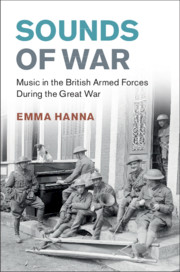Book contents
- Sounds of War
- Studies in the Social and Cultural History of Modern Warfare
- Sounds of War
- Copyright page
- Dedication
- Contents
- Figures
- Acknowledgements
- Abbreviations
- Introduction
- 1 Music in Britain, 1914
- 2 Recruitment and Fundraising
- 3 Instruments of War
- 4 Songs, Identity and Morale
- 5 Captivity
- 6 Religion and Pastoral Care
- 7 Medicine and Therapy
- 8 The Gramophone
- 9 Civilian Concert Parties
- 10 Servicemen’s Concert Parties
- 11 After the Armistice
- Conclusion
- Notes
- Sources and Select Bibliography
- Index
10 - Servicemen’s Concert Parties
Published online by Cambridge University Press: 20 February 2020
- Sounds of War
- Studies in the Social and Cultural History of Modern Warfare
- Sounds of War
- Copyright page
- Dedication
- Contents
- Figures
- Acknowledgements
- Abbreviations
- Introduction
- 1 Music in Britain, 1914
- 2 Recruitment and Fundraising
- 3 Instruments of War
- 4 Songs, Identity and Morale
- 5 Captivity
- 6 Religion and Pastoral Care
- 7 Medicine and Therapy
- 8 The Gramophone
- 9 Civilian Concert Parties
- 10 Servicemen’s Concert Parties
- 11 After the Armistice
- Conclusion
- Notes
- Sources and Select Bibliography
- Index
Summary
Examines the development of servicemen’s concert parties in the context of the rapid expansion of the fighting forces, and of the significant figures who were key to the provision of music for the purposes of recreation and amusement. This chapter will show that Britain’s armed forces each had a strong tradition of musical entertainments solely by servicemen for their comrades which was much bolstered by men who had been professional performers before they enlisted. Furthermore, this chapter will show that servicemen used the pantomime form to reinforce their belief that they were fighting in a just war.
Keywords
- Type
- Chapter
- Information
- Sounds of WarMusic in the British Armed Forces during the Great War, pp. 207 - 231Publisher: Cambridge University PressPrint publication year: 2020

